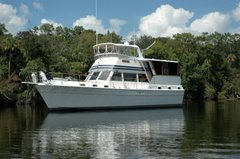Solomons to Annapolis
Two blog entries today. This is one of two.
After a day or two in Solomons I was feeling better and we went into town to see the Calvert Museum. There was not much in town other than many boat yards. This is the place to be if you need work done. We went to the museum and saw how the watermen made their living when crabs and, more particularly, oysters were the dominant money makers on the Chesapeake. There are boats that were built specifically on the Chesapeake for the oyster and crab harvesting. These were actually modifications of log canoes. The boats would be built of two, three, or five logs joined together. There was a large selection of original boats at the museum.
The smaller boats would then off load their catch onto larger "Buy" boats. One of the best examples of a buy boat is still in operation as a charter boat and is the oldest vessel currently certified by the Coast Guard as a passenger carrying vessel.
The museum also had a display of fossilized remains of whales and large sharks that were in the area eons ago. Apparently the cliffs around this part of the bay are loaded with fossils although most is private land.
The other big sport on the bay is waterfowl hunting. During the turn of the century, duck hunting was a major source of food and hunters devised many different ways to take more ducks. This was one method. The gun is called a "Punt" gun and was outlawed along with some other equally devastating firearms. Most of these are homemade from iron pipe.
This museum also had a display of fish, rays, skates and otters that make the bay home.
A unique type of lighthouse was built for the Chesapeake and one of the originals is on display at the museum. It is called a "Screw Pile" light house in that the supporting legs are literally screwed into the mud bottom and the lighthouse built on top of it. The bell was originally mounted up on the lighthouse and the keeper would wind a mechanical striker every two hours during fog so the bell could sound. One of the more unique structures is the "outhouse" that was built out over the water.
From Solomons we went to St. Michaels and anchored in San Domingo creek behind St. Michaels. Here we went to another large museum of the Chesapeake and it was much the same as the one in Solomons. The bird population is starting to change as we head further north. We started seeing Swans here and many more ducks.
We originally made plans to ride our bikes the next day to a ferry to go over to visit Oxford. After looking at the weather forecasts we determined that we were in for a few days of winds and thunderstorms and so we decided to leave St. Michaels and head for Annapolis the next day. We figured that if we were going to be waiting out weather somewhere we would rather be in Annapolis than St. Michaels. Other than the museum and some shops, there was not much else there to see. We headed for Annapolis the next day and on our way we went through Knapp's Narrows. This is a small canal cut through to save a few miles of travel. It was narrow and the entrance and exit was heavily shoaled. The bridge tender cautioned us to stay close to the markers and we did not realize how close until we saw a crab boat coming in as we were leaving that almost touched the marker making a turn into the narrows.
As we headed in to Annapolis we were passed by the YP "Yard Patrol" boats of the Naval Academy. These are boats used for seamanship training.
I'll cover Annapolis in the next entry.











